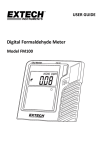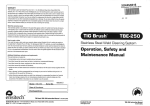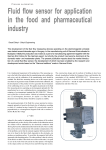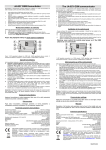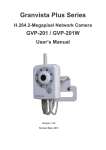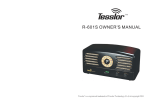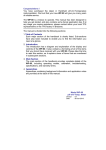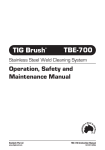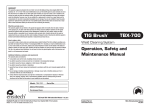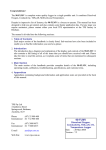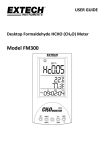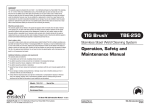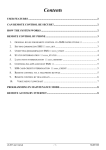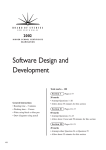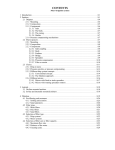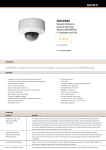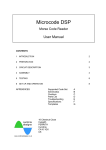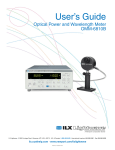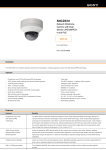Download Congratulations ! You have purchased the latest in Handheld
Transcript
Congratulations ! You have purchased the latest in Handheld Dissolved Oxygen-Temperature instrumentation. We trust that your new WP-82 will give you many years of reliable service. The WP-82 is a breeze to operate. This manual has been designed to help you get started, and also contains some handy application tips. If at any stage you require assistance, please contact either your local TPS representative or the TPS factory in Brisbane. The manual is divided into the following sections: 1. Table of Contents Each major section of the handbook is clearly listed. Sub-sections have also been included to enable you to find the information you need at a glance. 2. Introduction The introduction has a diagram and explanation of the display and controls of the WP-82. It also contains a full listing of all of the items that you should have received with your WP-82. Please take the time to read this section, as it explains some of items that are mentioned in subsequent sections. 3. Main Section The main section of the handbook provides complete details of the WP-82, including operating modes, calibration, troubleshooting, specifications, and warranty terms. 4. Appendices Appendices containing background information and application notes are provided at the back of this manual. TPS Pty Ltd 4 Jamberoo Street Springwood, Brisbane, Australia, 4127 Phone : (07) 32 900 400 International : 61 7 32 900 400 Fax : (07) 3808 4871 International : 61 7 3808 4871 E-mail : [email protected] Model WP-82 Dissolved OxygenTemp. Meter Handbook Version : 1.01 Date : 25 Mar 98 Author : MS Page 2 Contents 1. Introduction........................................................................................ 4 1.1WP-82 Display and Controls ............................................................................... 4 1.2 Unpacking Information ...................................................................................... 6 1.3 Specifications ..................................................................................................... 7 2. WP-82 Menu Structure ...................................................................... 9 3. Operating Modes ............................................................................. 10 4. Dissolved Oxygen Calibration ........................................................ 11 4.1 Calibration Procedure....................................................................................... 11 4.2 Calibration Notes ............................................................................................. 12 4.3 Calibration Messages ....................................................................................... 12 5. Temperature Calibration ................................................................. 13 5.1 Calibration Procedure....................................................................................... 13 5.2 Calibration Notes ............................................................................................. 13 5.3 Calibration Messages ....................................................................................... 13 6. Salinity Correction ........................................................................... 14 7. Altitude or Atmospheric Pressure Correction................................ 14 7.1 Selecting Altitude or Pressure Correction ......................................................... 14 7.2 Changing the Altitude or Pressure Correction value ......................................... 15 7.3 Notes................................................................................................................ 15 8. Good Laboratory Practices (GLP) .................................................. 16 8.1 To recall GLP information on the display ......................................................... 16 8.2 Failed Calibration............................................................................................. 17 8.3 Printing GLP Information to the RS232 Port .................................................... 17 8.4 Instrument Serial Number ................................................................................ 18 8.5 Additional GLP Features .................................................................................. 18 9. Notepad Function ............................................................................ 19 9.1 Recording Readings into the Notepad............................................................... 19 9.2 Recalling Records from the Notepad................................................................. 19 9.3 Erasing Records from the Notepad ................................................................... 20 9.4 Printing Records from the Notepad to the RS232 Port ...................................... 20 10. Automatic Datalogging .................................................................. 21 Page 3 11. RS232 Port ..................................................................................... 22 11.1 Setting the Baud Rate ..................................................................................... 22 11.2 Sending Readings to the RS232 Port .............................................................. 22 11.3 RS232 Configuration...................................................................................... 22 11.4 Communication and Statistical Software ........................................................ 22 11.5 Commands ..................................................................................................... 23 11.6 Data Format ................................................................................................... 24 12. Battery Saver Function.................................................................. 25 13. Clock Function............................................................................... 26 13.1 Setting the Clock............................................................................................ 26 13.2 Displaying or Hiding the Clock ...................................................................... 26 14. Initialising the WP-82 ..................................................................... 27 15. Instrument firmware version number. .......................................... 27 16. Troubleshooting ............................................................................ 28 16.1 General Errors................................................................................................ 28 16.2 Dissolved Oxygen Troubleshooting ................................................................ 29 16.3 Temperature Troubleshooting......................................................................... 29 17. Warranty ......................................................................................... 30 18. Dissolved Oxygen Sensor Fundamentals .................................... 32 18.1 Operating Principle ........................................................................................ 32 18.2 Maintenance Of The Membrane ..................................................................... 33 18.3 Probe Storage ................................................................................................. 33 18.4 Notes On Units Of Dissolved Oxygen ............................................................. 34 18.5 Equilibrium Conditions .................................................................................. 35 18.6 Velocity Past The Membrane.......................................................................... 36 Page 4 1. Introduction 1.1 WP-82 Display and Controls ´ ¬ - ® ¯ ° ± ² ³ Page 5 ¬ Press to record readings into memory. See section 9.1. Also used to switch the Altitude or Atmospheric Pressure Correction system on or off. See section 7.1. Press to show or hide the date, time and Altitude or Pressure. See section 13.2. ® Press to start or stop automatic logging. See section 10. Alternatively, press to transmit current reading plus date and time to the RS232 port (optional) See section 11.2. ¯ Only used within the menu system on the WP-82. ° Press to access the user-friendly menu system which makes the WP-82 easy to operate. ± and ³ The and keys are used for calibrating temperature readout (section 5.1), setting the clock (section 13.1), setting the automatic logging period (section 10), and displaying GLP information (section 8.1). The key is also used to intialise the WP-82 at turn-on. See section 14. ² Switches the WP-82 on and off. ´ Display 32 character alpha-numeric display with user-friendly menu and prompting system. Shows Dissolved Oxygen, Temperature simultaneously. Date, time, manual salinity value, altitude or pressure can also be displayed. Page 6 1.2 Unpacking Information Before using your new WP-82, please check that the following accessories have been included: 1.2.1 WP-82 1. WP-82 Dissolved Oxygen-Temperature Instrument 2. Battery charger 3. WP-82 Handbook Part No 123147 130037 130050 Options that may have been ordered with your WP-82: 1. ED500W Dissolved Oxygen-Temperature Sensor 2. RS232 Serial Interface Option (includes cable) 3. Hard Carry Case 4. Battery charger lead for 12V cigarette lighter socket 5. Solar Panel 6. RS232 Printer 123220 130039 130059 130046 130012 130031 Other spares: 1. 6V NiCad Battery 2. RS232 Interface Cable 130038 130041 1.2.2 WP-82Y 1. WP-82Y Dissolved Oxygen-Temperature Instrument 2. Battery charger 3. WP-82 / WP-82Y Handbook Part No 123148 130037 130050 Options that may have been ordered with your WP-82Y: 1. YSI Dissolved Oxygen-Temperature Sensor 2. 3m Cable for DO2 Sensor 3. RS232 Serial Interface Option (includes cable) 4. Hard Carry Case 5. Battery charger lead for 12V cigarette lighter socket 6. Solar Panel 7. RS232 Printer 123204 123221 130039 130059 130046 130012 130031 Other spares: 1. 6V NiCad Battery 2. RS232 Interface Cable 130038 130041 Page 7 1.3 Specifications ppM (mg/L) Ranges* Resolution Accuracy % Saturation Ranges* Resolution Accuracy % Gaseous Ranges* Resolution Accuracy : 0 to 20.00 ppM (ED500W and YSI sensors) 20.0 to 40.0 ppM (YSI sensor only) : 0.01 & 0.1 ppM : ±0.2% of full scale of selected range : 0 to 240.0 % Saturation (ED500W and YSI sensors) 240 to 450 % Saturation (YSI sensor only) : 0.1 & 1 % Saturation : ±0.3 % Saturation : 0 to 45.0 % Gaseous (ED500W and YSI sensors) 45 to 100 % Gaseous (YSI sensor only) : 0.1 & 1 % Gaseous : ±0.1 % Gaseous *Ranges subject to sensor performance. Automatic range selection for YSI sensor. Temperature Range Resolution Accuracy : -10.0 to 120.0 oC (Sensor limit 50 oC) : 0.1 oC : ±0.2 oC Salinity Correction : User-set, from 0 to 50.0 ppK NaCl Barometric Pressure Correction : User-set, from 800 to 1100 HPa Altitude Correction : User-set, from 0 to 5000m Page 8 General Specifications Temperature Compensation DO2 Sensor Span Range DO2 Sensor Zero Range Temp. Sensor Offset Range Automatic Calibration : : : : : Memory Automatic Logging : : RS232 Output (optional) : Clock : Battery Saver : Good Laboratory Practices : Power : Dimensions Mass : : Environment Dual automatic temperature compensation system. 70 to 135% 0 to 7.5% -10.0oC to +10.0oC Zero in Sodium Sulphite (Na2SO3) Solution Span in Air. 150 readings including date and time User-set for one reading every 1 to 90 seconds or minutes. 300, 1200 & 9600 baud. 8 bits, no parity, 1 stop bit, XON/XOFF Protocol. Calendar clock displays date, month, hours, minutes & seconds. Year is recorded in memory and transmitted to optional RS232 port, but is not displayed. On : Auto switch-off after 5 minutes Off : Continuous use Bar Graph display of battery charge level. Readout of battery voltage available for troubleshooting. Date, Time and Value of last Dissolved Oxygen and Temperature calibration are stored, along with Altitude or Pressure setting at time of calibration. This information can be recalled or sent to the optional RS232 port at any time. 6V NiCad Rechargeable Battery for approx 75 hours operation. 187 x 110 x 51 mm Instrument only : Approx 440g Full Kit : Approx 1.5kg Temperature : 0 to 45 oC Humidity : 0 to 90 % R.H. Page 9 2. WP-82 Menu Structure A detailed breakdown of the menu system of the WP-82 is shown below. This diagram provides a quick reference for the menu functions available for the WP-82. Press the function keys in normal display mode, to perform the following tasks: F1 F2 F3 : Press to record current data plus date and time into memory. : Press to show or hide date/time and altitude or pressure setting. : Press to start and stop automatic logging. If logging period is set to zero, press to transmit current reading plus date and time to the RS232 port. Menu : Press to access the user-friendly menu system, as detailed below. F1:Cal. F1:Oxy F2:Temp F3:Sal (if ppM-Sal mode selected) F4:Altitude OR Pressure (if one or the other is selected) F2:Notepad F1:Recall F2:Erase F3:Print (if RS232 option fitted) F4:Prog. F1:Min F2:Sec ↑↓:Set Period F3:Mode F1:ppM-Sal F2:ppM F3:%Sat F4:%Gas F4:Setup F1:Batt F1:OFF F2:ON F2:Clock F3:GLP F1:Recall F3:Print F4:Baud F1:300 F2:1200 F3:9600 (if RS232 option fitted) Page 10 3. Operating Modes The WP-82 has four operating modes : Salinity-corrected ppM, uncorrected ppM, % Saturation, and % Gaseous. To select a mode, access the mode menu by pressing , then F3:Mode. 1. F1:ppM-Sal (Salinity-corrected ppM readout) Displays Salinity-corrected ppM Dissolved Oxygen, Temperature and the user-set Salinity value simultaneously. See section 13.2 for details on how to show or hide the date and time. eg: 10.00ppM 25.0oc 36.0ppK 12:00:00 2. F2:ppM (ppM readout with no salinity correction) Displays ppM Dissolved Oxygen and Temperature readings simultaneously. See section 13.2 for details on how to show or hide the date and time. eg: 10.00ppM 25.0oc 31/12 12:00:00 3. F3:%Sat (% Saturation readout) Displays % Saturation Dissolved Oxygen and Temperature readings simultaneously. See section 13.2 for details on how to show or hide the date and time. eg: 100.0%S 25.0oc 31/12 12:00:00 4. F4:%Gas (% Gaseous readout) Displays % Gaseous Oxygen and Temperature readings simultaneously. See section 13.2 for details on how to show or hide the date and time. o eg: 20.9%G 25.0 c 31/12 12:00:00 5. Notes 1) If the temperature of the solution exceeds 120.0 oC, or the temperature sensor inside the dissolved oxygen sensor is faulty, the temperature reading is replaced by “OVRoc”, to signify the over-range condition. 2) The decimal point is replaced by a “∗ ∗ ” if a Dissolved Oxygen or Temperature calibration has failed (sections 4.1 and 5.1) or if the unit is initialised (section 14). Page 11 4. Dissolved Oxygen Calibration 4.1 Calibration Procedure Plug the Dissolved Oxygen sensor into the Sensor socket. Switch the meter on. Select the mode of your choice. → F3:Mode → F1 to F4 Ensure that temperature has already been calibrated (see section 5.1). NOTE: A ∗ in place of the decimal point in the temperature readout indicates that temperature is not calibrated. 5. Rinse the Dissolved Oxygen sensor in distilled water and blot dry. 6. Zero Calibration (a) Place the sensor into an oxygen-free solution. This solution may be prepared by dissolving 2g of Sodium Sulphite in 100mL of distilled water. A 50g bottle of Sodium Sulphite powder is supplied with a new ED500W sensor for this purpose (part number 123302). (b) Allow the reading to stabilise at or near zero. This may take 2-3 minutes. (c) Select Oxygen Calibration. → F1:Cal. →F1:Oxy (d) Press the key to calibrate. (e) A “∗” will not be removed from the display after a Zero Calibration. 7. Rinse the Dissolved Oxygen sensor in distilled water and blot dry. 8. Air Calibration (a) Hang the Dissolved Oxygen sensor in air. The tip of the sensor should be pointing downwards. (b) Allow the reading to stabilise. After a zero calibration, this may take up to 5 minutes. (c) Select Oxygen Calibration. → F1:Cal. → F1:Oxy (d) Press the key to calibrate. (e) A “∗” in the display will be replaced by a decimal point after a successful air calibration. 9. The WP-82 is now calibrated and is ready for use. NOTES: When taking sample measurements, always ensure that there is adequate flow of solution past the membrane for accurate, stable readings. See section 18.6. If salinity-corrected ppM Dissolved Oxygen readings are required, set the salinity correction value before taking sample measurements. See section 6. If Altitude or Atmospheric Pressure Correction is selected, set the correction value before calibrating and taking measurements. See section 7. 1. 2. 3. 4. Page 12 4.2 Calibration Notes 1. A zero calibration should be performed at least monthly. In applications where there is a low level of dissolved oxygen, a zero calibration may have to be done weekly. 2. An air calibration should be performed at least weekly. Of course, more frequent calibration will result in greater confidence in results. 3. The salinity correction value is ignored during zero and air calibration. There is therefore no need to re-set the salinity correction value when calibrating Dissolved Oxygen. 4. For optimum accuracy, set the altitude of atmospheric pressure before calibration. 5. All calibration information is retained in memory when the WP-82 is switched off, even when the battery is removed. This information can be recalled or printed later using the GLP function (see section 8). 4.3 Calibration Messages 1. If a Zero calibration has been successfully performed, the WP-82 will display the following message, and the zero value of the sensor. eg: Zero Cal. OK Zero= 0.0% 2. If an Air calibration has been successfully performed, the WP-82 will display the following message, and the span value of the sensor. eg: Air Cal. OK Span=100.0% 3. If an Air calibration has failed, the WP-82 will display the following message, and the failed span value of the sensor. eg: Air Cal. Fail or Air Cal. Fail Span= 65.0% Span=140.0% Page 13 5. Temperature Calibration 5.1 Calibration Procedure 1. Plug the Dissolved Oxygen/Temperature sensor into the Sensor socket. 2. Switch the meter on. 3. Place the sensor into a beaker of room temperature water, alongside a good quality mercury thermometer. Stir the sensor and the thermometer gently to ensure an even temperature throughout the beaker. 4. Select Temperature Calibration. → F1:Cal. → F2:Temp 5. The reading from the probe is now displayed on the right of the display, and the value you are going to set is shown on the left. eg: → 25.0← ← 20∗ ∗ 0 oc ↑ ↓ :Set F1:Cal. 6. When the reading on the right has stabilised, press the and keys until the reading on the left shows the same temperature as the mercury thermometer. 7. Press the key to calibrate the temperature readout. The ∗ will now be replaced by a decimal point, if calibration was successful. Alternatively, press the key to abort temperature calibration. 5.2 Calibration Notes 1. Temperature calibration information is retained in memory when the WP-82 is switched off, even when the battery is removed. This information can be recalled or printed later using the GLP function (see section 8). 2. Temperature does not need to be recalibrated unless the sensor is replaced or the meter is initialised. 5.3 Calibration Messages 1. If a temperature calibration has been successfully performed, the WP-82 will display the following message and the offset value of the probe. eg: Calibrate OK Offset= 1.0oc 2. If a temperature calibration has failed, the WP-82 will display the following message, and the failed offset value of the probe. eg: Calibrate Fail Offset= 10.5oc Page 14 6. Salinity Correction Manual salinity correction for ppM Dissolved Oxygen readings is available on the WP-82. → F3:Mode → F1:ppM-Sal 1. Select Salinity-corrected ppM mode. 2. Set the Salinity correction value. → F1:Cal → F3:Sal 3. The current salinity correction value is now displayed. eg: → 36.0← ← ppK Sal. ↑ ↓ :Set F1:Save 4. Press the and keys until the display shows the desired salinity correction value. 5. Press the key to save the salinity correction value. Alternatively, press the key to quit and retain the current setting. 7. Altitude or Atmospheric Pressure Correction Manual altitude or atmospheric pressure correction are available on the WP-82. Either one or the other may be selected at any one time or the system can be switched off. 7.1 Selecting Altitude or Pressure Correction 1. Switch the WP-82 off, by pressing the key. 2. Press and hold the key while switching the WP-82 back on with the key. 3. The Altitude or Pressure mode menu is now displayed. eg: F1:Altitude F3:Pressure → F4:OFF The arrow indicates the current selection. 4. Press to select Altitude correction. Press to select Atmospheric Pressure correction. Press to switch the Altitude or Pressure correction system OFF. 5. If or was selected, then the WP-82 now asks for the altitude or pressure. eg: → 0← ← m Alt or → 1013← ← HPa ↑ ↓ :Set F1:Save ↑ ↓ :Set F1:Save Press the and keys to set the desired Altitude or Pressure. 6. Press the key to save the Altitude or Pressure value. Alternatively, press the key to quit and retain the current setting. Page 15 7.2 Changing the Altitude or Pressure Correction value To change the altitude or atmospheric pressure correction value when one or the other is switched on: key. 1. Switch the WP-82 on with the 2. Select Altitude or Pressure calibration, depending upon which is switched on: ie: → F1:Cal. → F3:Altitude or → F1:Cal. → F3:Pressure 3. The WP-82 now asks for the altitude or pressure. eg: → 0← ← m Alt or → 1013← ← HPa ↑ ↓ :Set F1:Save ↑ ↓ :Set F1:Save and keys to set the desired Altitude or Pressure. Press the 4. Press the key to save the Altitude or Pressure value. Alternatively, press the key to quit and retain the current setting. 7.3 Notes 1. For optimum accuracy, the altitude or pressure should be set before calibrating or taking measurements. 2. When the altitude or atmospheric pressure correction system is switched off, the WP-82 assumes sea level (0m) and 1013 HPa conditions. These values are satisfactory for the precision required for most Dissolved Oxygen measurements. 3. If Altitude correction is switched on, an “A” is added to the WP-82 display in normal measurement mode. 4. If Atmospheric Pressure correction is switched on, a “P” is added to the WP-82 display in normal measurement mode. 5. % Saturation and % Gaseous readings are normalised to sea level (0m) and 1013HPa, when altitude or atmospheric pressure compensation is in use. 6. ppM and salinity-corrected ppM modes show the actual oxygen present at the user-set altitude or atmospheric pressure. Page 16 8. Good Laboratory Practices (GLP) The WP-82 keeps a record of the date and time of the last Dissolved Oxygen, and Temperature calibrations as part of GLP guidelines. 8.1 To recall GLP information on the display 1. Switch the meter on. 2. Select the GLP menu. → F4:Setup → F3:GLP 3. Select recall. F1:Recall 4. The instrument model, firmware version number, and instrument serial number are displayed, along with a prompt describing how to scroll through the GLP information. eg: WP82 V1.0 R1234 or WP82Y V1.0 R1234 ↓ :More ↑ :Back ↓ :More ↑ :Back 5. Press the key to sequentially scroll through the GLP information for all parameters. Press the key to scroll back to previous data. The sequence of information displayed is shown below. Press to abort at any time. WP82 V1.0 R1234 ↓ :More ↑ :Back Oxy Zero 0.0% @ 31/12/97 11:00 Oxy Span 100.0% @ 31/12/97 11:10 Altitude 5000m @ 31/12/97 11:20 * OR Pressure 1013HPa * @ 31/12/97 11:20 Temp Offset 1.0oc @ 31/12/97 11:30 Exit * Altitude OR Pressure are displayed if either one was switched on at the time of the last calibration. If the Altitude or Pressure Correction system was switched off at the time of the last calibration, then the GLP moves directly from Oxygen Span to Temperature Offset. Page 17 8.2 Failed Calibration If calibration has failed, the GLP function will reset the date and time to zero. The WP-82 still shows the results of the last successful calibration. eg: Oxy Zero 0.0% Oxy Span 100.0% @ 00/00/00 00:00 @ 00/00/00 00:00 Altitude 5000m Pressure 1013HPa Temp Offset 1.0oc @ 00/00/00 00:00 @ 00/00/00 00:00 @ 00/00/00 00:00 Note that these calibration values are still used if further measurements are taken without recalibrating. 8.3 Printing GLP Information to the RS232 Port The GLP information stored in the instrument’s memory can be sent to a printer or PC via the RS232 port. This function is available only when the optional RS232 port is fitted. 1. Switch the meter on. 2. Ensure that the WP-82 RS232 cable is connected to the instrument and to the printer or PC. 3. Send the GLP information to the RS232 port: → F4:Setup → F3:GLP → F3:Print 4. The GLP information is sent to the RS232 port in formatted ASCII text. eg: WP82 V1.0 R1234 @ 31/12/97 12:00 Oxygen Oxygen Oxygen Oxygen Temperature ENDS NOTE: Zero= 0.0% Span= 100.0% Altitude= 5000m Pressure= 1013HPa Offset= 1.0oC @ @ @ @ @ 31/12/97 31/12/97 31/12/97 31/12/97 31/12/97 11:00 11:10 11:20 11:20 11:30 Either Altitude OR Pressure is sent, depending upon which was selected the last time the instrument was calibrated. If the Altitude or Pressure Correction was switched off at the time of the last calibration, then neither is displayed. Page 18 8.4 Instrument Serial Number In case the serial number that is fitted to the rear of the WP-82 is removed or becomes illegible, it is also available on the WP-82 display. • The serial number is displayed at turn-on, eg: WP-82 V1.0 R1234 Oxygen Temp. where R1234 is the serial number. • The serial number is display when recalling the GLP information (section 8.1). • The serial number is included on the printout of GLP information (section 8.3). 8.5 Additional GLP Features Another GLP requirement is to record the date and time of every reading. The WP-82 does this for you when readings are recorded either with the Notepad function (section 9) or the Automatic Logging function (section 10). Page 19 9. Notepad Function 9.1 Recording Readings into the Notepad To record readings into the Notepad memory: in normal display mode. The display should now look like this: 1. Press eg: 10.00ppM 25.0oc F1: 1 12:00:00 2. If you now press , the Dissolved Oxygen, Temperature, Date and Time will be recorded into the notepad, and labeled as reading number 1. If manual salinity, altitude or pressure correction are in use, then are also recorded with the reading. 3. Repeat steps 1 & 2 as often as required. The maximum number of readings that can be stored in the Notepad is 150. 9.2 Recalling Records from the Notepad To recall records from the Notepad onto the WP-82 display: 1. Select the Notepad menu → F2:Notepad 2. Select Recall from the menu F1:Recall 3. Record number 1 is now displayed. Salinity is displayed for readings recorded in salinity-corrected ppM mode. An “A” is displayed if Altitude correction was switched on or a “P” is displayed if Pressure correction was switched on when the reading was recorded. eg: 10.00ppM A 25.0oc or 10.00ppM P 25.0oc 36.0ppK 1 F2:Clk 36.0ppK 1 F2:Clk 4. Press to alternatively display the date and time or the data for this record. The Altitude or Pressure correction value is displayed with the date and time if either was switched on when the reading was recorded. eg: 31/12 12:00:00 or 31/12 12:00:00 5000m 1 F2:Dat 1013HPa 1 F2:Dat Press to move forward through the records. Press to move backward through the records. Press and hold the or keys to roll rapidly through the readings. Page 20 9.3 Erasing Records from the Notepad To erase all records from the Notepad: → F2:Notepad 1. Select the Notepad menu 2. Select Erase from the menu F2:Erase 3. The WP-82 now asks if you are sure that you wish to erase all records. Erase, You Sure? F1:Yes F2:No 4. Press to erase all records from the Notepad Press to quit without erasing the records from the Notepad. 9.4 Printing Records from the Notepad to the RS232 Port This function is only available when the optional RS232 port is fitted. 1. Connect one end of the RS232 cable to the Charger/RS232 socket of the WP-82. The charger, optional solar panel, or optional car battery lead can be connected into the spare socket on the cable for long term use, if required. 2. Connect the other end of the RS232 cable to an RS232 Printer, or to COM1 or COM2 of a PC. 3. Ensure that the baud rate for the printer or PC and the WP-82 are the same. If necessary, alter the baud rate of the WP-82 (see section 11.1). The WP-82 uses XON/XOFF protocol. Ensure that the printer is set accordingly. 4. Select the Notepad menu. → F2:Notepad 5. Select Print from the menu. F3:Print Printing starts as soon as is pressed. The display shows the word “Printing” until printing is completed. Page 21 10. Automatic Datalogging The WP-82 can automatically log records into the Notepad. First the logging period must be programmed, then automatic logging can be started and stopped as required. → F2:Notepad → F4:Prog. 1. Select the Program menu 2. The display should now look like this: eg: → 00← ← F1:Min F2:Sec ↑ ↓ :Set Period and keys to set the period at which the WP-82 will 3. Use the automatically log records. 4. When the logging period has been correctly set, select whether this period is in minutes or seconds. Press to save the period as minutes. press to save the period as seconds. eg: If the period was set to 05, followed by , then the WP-82 will automatically log a record every 5 seconds. 5. If the optional RS232 port is fitted, the WP-82 will ask if the records are to be logged into the Notepad, or sent directly to the RS232 port. Press to log records into the Notepad (maximum of 150 readings). Press to send records directly to the RS232 port. 6. The automatic logging function is now programmed, and can be started and stopped as required. 7. To start automatic logging, press in normal display mode. If the WP-82 is logging into the Notepad, the display will look like this: eg: 10.00ppM 25.0oc Log# 1 12:00:00 The log number will increment and the WP-82 will beep each time a reading is recorded. If the WP-82 is sending records directly to the RS232 port, the display will look like this: eg: 10.00ppM 25.0oc Sending 12:00:00 The WP-82 will beep each time a record is sent to the RS232 port. 8. Press to stop automatic logging. 9. Note: The clock must be set before the WP-82 will allow automatic logging to start. The message “Clock Not Set” is displayed if the clock is not set. Page 22 11. RS232 Port This section is applicable if the optional RS232 port is fitted. 11.1 Setting the Baud Rate → F4:Setup → F4:Baud 1. Select the RS232 Set-up menu 2. The available baud rates are listed on the display. ie: F1:300 F2:1200 → F3:9600 The arrow shows the current selection. 3. Press to select 300 baud Press to select 1200 baud Press to select 9600 baud. Press to quit and retain the current setting. 11.2 Sending Readings to the RS232 Port Press to instantly send readings to the RS232 port whenever the WP-82 is in normal display mode. This function is disabled if the automatic logging period is set to greater than zero (see section 10). Records can be sent directly to the RS232 port rather than stored in memory during automatic datalogging. See section 10 for details. 11.3 RS232 Configuration The WP-82 RS232 configuration is 8 bits, No Parity, 1 Stop Bit, XON/XOFF Protocol. 11.4 Communication and Statistical Software Communication between the WP-82 and a PC can be handled with any RS232 communication software. The diskette supplied by TPS contains a BASIC program for this purpose. Once the data is saved to disk, the next problem is how to use it. The data is formatted columns that can be imported by programs such as Microsoft® Excel® and Lotus 123®. Information on how to use the software is provided in the README files on the diskette. Page 23 11.5 Commands The following commands can be sent from a PC to the WP-82. Note that <cr> denotes carriage return and <lf> denotes a line feed. Action Request current data Command ?D<cr> Request logged data ?R<cr> Erase logged data ?E<cr> Request status information ?S<cr> Request GLP information ?G<cr> Notes Returns the current Dissolved Oxygen, Temperature, date and time from the WP-82. Also returns salinity, altitude and pressure correction values if any of these are in use. The log number returned is set to Zero. Returns all logged records from the WP-82 memory. The data ends with the message ENDS<cr> Erases all logged records from the WP-82 memory. Returns the message ERASED<cr> to confirm that the records have been erased. Returns the model name, firmware version number, instrument serial number and number of logged readings in memory, eg: WP82ssV1.0sR1234s9999<cr>, where s are spaces. Note that the number of logged readings is rightjustified. Returns all calibration GLP information, plus the instrument model and current date (see section 11.6 for data format and handshaking). Page 24 11.6 Data Format A. Data is returned to the RS232 port by the WP-82 in the following format when requested by a PC with the ?D or ?R commands (section 11.5): LLLLssDDDDDDUUUssSSSSSSppKssTTTTTToCss ssAAAAAAuuussdd/mm/yysshh:mm:ss<cr> or B. Data is sent to the RS232 port by the WP-82 in the following format when it is sent by the WP-82 using the Print function (section 9.4) or the Instant Send function (section 11.2): LLLLssDDDDDDUUUssSSSSSSppKssTTTTTToCss ssAAAAAAuuussdd/mm/yysshh:mm:ss<cr><lf> where: LLLL s DDDDDD UUU s SSSSSS ppK s TTTTTT oCss s AAAAAA uuu s dd/mm/yy s is the Log Number. Maximum 4 characters, right justified. The WP-82 sends a Zero for instant readings (section 11.2) is one space. is the Oxygen Data. Maximum 6 characters, right justified. is the unit description, either “ppM”, “%Sss”, or “%Gss”, (where s is 1 space) is one space. is the Salinity correction value. Maximum 6 characters, right justified. is the salinity correction value unit description. is one space. is the Temperature Data. Maximum 6 characters, right justified. is the Temperature unit description, (where s is 1 space). is one space. is the Altitude OR Pressure correction value. Maximum 6 characters, right justified. is the unit description, either “mss” for Altitude or “HPa” for Atmospheric Pressure, (where s is 1 space). is one space. is the date, month and year data. is one space. hh:mm:ss is the hours, minutes and seconds data. Page 25 GLP information is returned as 5 or 6 lines terminated by a carriage return. When using the “?G” command (section 11.5), the computer must respond with a character after receiving each line. C. eg: WP82 V1.0 R1234 @ 31/12/97 12:00 Oxygen Zero= 0.0% @ 31/12/97 Oxygen Span= 100.0% @ 31/12/97 Oxygen Altitude= 5000m @ 31/12/97 Oxygen Pressure= 1013HPa @ 31/12/97 Temperature Offset= 1.0oC @ 31/12/97 ENDS 11:00 11:10 11:20 11:20 11:30 NOTE: Either Altitude OR Pressure is sent, depending upon which was selected the last time the instrument was calibrated. If the Altitude or Pressure Correction was switched off at the time of the last calibration, then neither is displayed. 12. Battery Saver Function The WP-82 is equipped with a battery saver function. If no button has been pressed for five minutes, the unit beeps and flashes the display for 20 seconds, and then shuts off. This function can be switched off for continuous use. To enable or disable the battery saver function: 1. Switch the meter on. 2. Select Battery Saver Set-up → F4:Setup → F1:Batt 3. The battery saver menu is now displayed. eg: Batt Saver F1:OFF 100%→ → F2:ON The arrow indicates the current selection. The bar graph and percentage indicate the approximate level of charge in the battery. 4. Press to disable the battery saver function for continuous use. Press to enable the battery saver function. The meter will switch itself off if no key has been pressed for five minutes. Press to quit the battery saver menu and retain the current setting. 5. NOTE: For troubleshooting purposes, the battery volts can also be displayed in the battery saver menu. Press to display battery volts. The symbol flashes when the battery volts drops below 5.60 volts. At 5.00 volts the meter turns itself off. Page 26 13. Clock Function 13.1 Setting the Clock → F4:Setup → F2:Clock 1. Select the Clock Set-up menu 2. The display now shows the current date and time. The cursor starts at the day. eg: 31/12/96 12:00 F1:← ← F2:→ → ↑ ↓ :Set 3. Press the and keys until the day is correct. 4. Press to move to the month. Press the and keys until the month is correct. 5. Press to move to the year. Press the and keys until the year is correct. 6. Press to move to the hour. Press the and keys until the hour is correct. 7. Press to move the cursor to the minutes. Press the and keys until the minutes are correct. 8. Check that the date and time are correct. Press to save the settings. If any changes are needed, press the key to move left to the desired position. Press to quit without resetting the clock. Notes 1. The WP-82 does not test for a valid day of the month when setting the clock (eg: attempting to enter 31/02/96 is not corrected). 2. The WP-82 does test for leap years. 13.2 Displaying or Hiding the Clock The date and time are normally displayed along with the Dissolved Oxygen and Temperature readings. In salinity-corrected ppM mode, the salinity correction factor is displayed instead of the date. Press in normal display mode to hide the date and time. Press again to display the time plus the date. In salinity-corrected ppM mode, the salinity correction factor, replaces the date after 5 seconds. Page 27 14. Initialising the WP-82 If the calibration settings of the WP-82 exceed the allowable limits, the unit may need to be initialised to factory default values. To initialise the WP-82: key. 1. Switch the WP-82 off, by pressing the 2. Press and hold the key while switching the WP-82 back on with the key. 3. The following messages should be displayed: Initialized then: WP82s V1.0 R1234 MUST ReCalibrate Oxygen Temp. (The “s” after WP-82 is shown when the RS232 serial port option is fitted) 4. The meter then displays Dissolved Oxygen and Temperature. Note that the decimal points have been replaced with a ∗, to indicate that the unit requires recalibration. 5. When the WP-82 is initialised: (a) The manual salinity correction value is re-set 36.0ppK. See section 6 if you wish to change this value. (b) The Altitude or Pressure correction system is switched off, and the instrument assumes sea level (0m) and 1013HPa. 15. Instrument firmware version number. If you need to phone or fax TPS for any further technical assistance, the version number of your WP-82 firmware may of benefit to us. The version number is displayed by the WP-82 at turn-on. Page 28 16. Troubleshooting 16.1 General Errors Error Message Possible Causes Remedy Factory Cal. Failed See Handbook Memory Failed Calibration Lost Initialised MUST ReCalibrate The EEPROM chip which contains the factory calibration information has failed. User calibration settings have been lost or corrupted. The unit must be returned to TPS for service. Flashing Battery is below 5.60 volts. symbol. Meter displays the word OFF, and switches off. Battery is below 5.00 volts. Meter will not turn on. 1. Battery is exhausted. Battery does not charge up when charger is connected. Re-calibrate the instrument. Both Zero and Air calibration will be required for Dissolved Oxygen (see section 4.1) and a 1 point calibration for temperature (see section 5.1). Recharge the battery. Note that the unit will switch itself off when the battery falls below 5.00 volts. Recharge the battery. If this fails, check the charger. If charger OK, replace the battery. Recharge the battery. If this fails, check the charger. If charger OK, replace the battery. 2. Faulty Instrument 1. Faulty battery charger or faulty battery. Return to factory for repair. Connect the charger and switch the power on. Display the battery volts in the battery saver menu (section 12). If the battery volts are increasing then the charger is OK. If the battery volts do not increase, then the charger is faulty. Replace the charger or the battery, as required. 2. Faulty instrument. Return to factory for repair. Page 29 16.2 Dissolved Oxygen Troubleshooting Symptom Possible Causes Remedy Unit fails to calibrate, even with new sensor. • Zero calibration fails (Zero is greater than 7.0%) • Air calibration fails (Span is less than 70% or greater than 135%). • Unstable or inaccurate readings. Calibration settings outside of allowable limits due to previous failed calibration. 1. Membrane is leaking or broken. 2. Gap between membrane and gold cathode is dry. Initialise the unit. See section 14, Initialising the WP-82. Blackened Silver anode wire Electrode has been exposed to sulphides or other chemical poisoning. Electrode has been chemically poisoned or physically damaged. 1. Electrode has not yet polarised. Tarnished or scratched Gold cathode. Meter reads OVR ppM or OVR%. 3. Incorrectly fitted membrane. 4. Electrode is empty. 5. Electrode is faulty. 2. Electrode is faulty Replace membrane and refill electrode. Undo the barrel 3 turns, then re-tighten to re-flush the filling solution. Membrane should be smooth and convex with no wrinkles. Re-fit membrane if necessary. Replace membrane and re-fill electrode. Return electrode to factory for repair or replacement Return to the TPS factory for cleaning and service. Return to the TPS factory for cleaning and service. Wait for 2-3 minutes for the electrode to polarise after the WP-82 is switched on. Return electrode to factory for repair or replacement. 16.3 Temperature Troubleshooting Symptom Possible Causes Remedy Displays “OVRoC” when electrode is plugged in. 1. Faulty electrode. Return electrode to factory for repair or replacement. 2. Faulty instrument. 1. Faulty connector. Return to factory for repair. Check the connector and replace if necessary. 2. Faulty electrode. Return electrode to factory for repair or replacement. 3. Faulty instrument. Return to factory for repair. Temperature inaccurate and cannot be calibrated. Page 30 17. Warranty TPS Pty. Ltd. guarantees all instruments and electrodes to be free from defects in material and workmanship when subjected to normal use and service. This guarantee is expressly limited to the servicing and/or adjustment of an instrument returned to the Factory, or Authorised Service Station, freight prepaid, within twelve (12) months from the date of delivery, and to the repairing, replacing, or adjusting of parts which upon inspection are found to be defective. Warranty period on electrodes is three (3) months. There are no express or implied warranties which extend beyond the face hereof, and TPS Pty. Ltd. is not liable for any incidental or consequential damages arising from the use or misuse of this equipment, or from interpretation of information derived from the equipment. Shipping damage is not covered by this warranty. PLEASE NOTE: A guarantee card is packed with the instrument or electrode. This card must be completed at the time of purchase and the registration section returned to TPS Pty. Ltd. within 7 days. No claims will be recognised without the original guarantee card or other proof of purchase. This warranty becomes invalid if modifications or repairs are attempted by unauthorised persons, or the serial number is missing. PROCEDURE FOR SERVICE If you feel that this equipment is in need of repair, please re-read the manual. Sometimes, instruments are received for "repair" in perfect working order. This can occur where batteries simply require replacement or re-charging, or where the electrode simply requires cleaning or replacement. TPS Pty. Ltd. has a fine reputation for prompt and efficient service. In just a few days, our factory service engineers and technicians will examine and repair your equipment to your full satisfaction. To obtain this service, please follow this procedure: Return the instrument AND ALL SENSORS to TPS freight pre-paid and insured in its original packing or suitable equivalent. INSIST on a proof of delivery receipt from the carrier for your protection in the case of shipping claims for transit loss or damage. It is your responsibility as the sender to ensure that TPS receives the unit. Page 31 Please check that the following is enclosed with your equipment: • Your Name and daytime phone number. • Your company name, ORDER number, and return street address. • A description of the fault. (Please be SPECIFIC.) (Note: "Please Repair" does NOT describe a fault.) • either $13.50 for return freight for units under warranty, or $24 to cover inspection costs and return freight. (These amounts are not applicable to full-account customers.) Your equipment will be repaired and returned to you by air express where possible. For out-of-warranty units, a repair cost will be calculated from parts and labor costs. If payment is not received for the additional charges within 30 days, or if you decline to have the equipment repaired, the complete unit will be returned to you freight paid, not repaired. For full-account customers, the repair charges will be debited to your account. • Always describe the fault in writing. • Always return the sensors with the meter. Page 32 18. Dissolved Oxygen Sensor Fundamentals The electrode used, is the amperometric type of Clark Electrode and is suitable for the measurement of oxygen pressures in the range 0 to 100 cm of mercury. While the probe actually reads partial pressure of oxygen, the circuit is calibrated to be read in percentage saturation or parts per million (Milligrams/litre). The operation of probes of the Clark type relies on the diffusion of oxygen through a suitable membrane into a constant environment of 0.1 molar potassium chloride. Measurements are best performed with a reasonable flow past the membrane. At sufficiently high flow rates, the oxygen current is totally independent of the flow (few cms./sec.). The cell must not be shaken however or unstable readings will result from electrolyte surge bringing new oxygen from the reservoir to the working cathode surface. 18.1 Operating Principle The Clark oxygen electrode consists of a gold cathode and a silver/silver chloride anode, placed in an electrolyte solution. This solution is contained behind a plastic membrane. In this case the plastic is 0.025mm intermediate density polyethylene sheet. PTFE (Teflon) can be supplied for special applications. It must be realised that using membranes of very different thicknesses will result in an error in the temperature compensation that is applied in the instrument for the membrane permeability. This coefficient (here +4.2%/oC at 25oC) is for this thickness polyethylene. A polarizing voltage of about 800 millivolts is applied between the two electrodes. The gold electrode is placed close to the membrane and because of the polarizing voltage, oxygen diffusing through the membrane will be reduced at the gold electrode. Equation: O2 + 2H+ + 2 electrons → H2O2 This reduction process will produce a current through the oxygen electrode. A load resistor (actually a thermistor in this case) situated in the electrode itself, converts this current into a voltage proportional to the oxygen partial pressure. The thermistor provided within the body of the electrode can have a temperature coefficient of -4.2%/oC. This gives an accurate temperature compensation for the temperature/permeability effect of the membrane to oxygen, over a range of ± 20oC about a centre value of 25oC. Note this compensation is not for the solubility effects. A separate sensor also included achieves this. Page 33 18.2 Maintenance Of The Membrane The membrane does not require replacement as long as it remains intact. If punctured or suspected of leaking around the edges, it must be replaced. To replace the membrane: 1. Unscrew the lower barrel and carefully remove it from the probe. Ensure that the internal lexan barrel is not touched with the fingers, as the metallic surfaces are easily contaminated. 2. Remove the plastic cap and membrane from the end of the barrel. 3. Cut a 30 mm square (approx) piece of membrane material from your probe maintenance kit. Hold this over the end of the barrel, and push the plastic retaining cap back into place evenly. A little moisture on the outside of the membrane will let the cap slip on easily. The excess membrane may be trimmed off with a razor blade. 4. Pour enough 0.1 Molar KCl solution into the barrel to fill only 1/3. 5. Push the barrel carefully onto the lexan internal rod. As this is done, check for leaks on the membrane. The internal rod can be used to gently "pump" the membrane to check for leaks. 6. If no leaks can be seen, screw the outer barrel into place, so that the membrane is evenly and smoothly stretched over the gold internal cathode (gold bead at end). DO NOT OVERTIGHTEN. If the probe is washed off and put in fresh water, then, by viewing obliquely in a strong light, it is possible to see electrolyte "streaming" from the tip if it is leaking (even slowly). The effect is one of differential refractive index and is quite sensitive. If the response is low, or zero impossible, or reading overranged, fit a new membrane. 18.3 Probe Storage The Oxygen probe should be kept moist when not in use to prevent the thin film of electrolyte behind the membrane from drying out. To achieve this, the probe can be stored with the tip in water. For long term storage of several weeks or more, remove and empty the barrel. Replace the barrel with the membrane intact. When the electrode is stored in this way, the membrane should be replaced and the electrode refilled before use. Page 34 18.4 Notes On Units Of Dissolved Oxygen The terms "Oxygen Concentration" and "Oxygen Partial Pressure" frequently give rise to some confusion. • Oxygen Concentration is the absolute quantity of oxygen present per unit mass of the liquid. • Oxygen Partial Pressure is the oxygen fraction of the total pressure of all of the gases present. For any one liquid system, Oxygen Concentration and Oxygen Partial Pressure are proportional. However, if the solubility of oxygen in the liquid should change owing to increased quantities of solutes, etc., then the ratio of the Concentration to the Partial Pressure must change. Thus, if one saturates distilled water and a 25% solution of Sodium Chloride with air at atmospheric pressure (25oC) both solutions will have almost exactly the same Oxygen Partial Pressure, namely 15.5 cms of mercury. However, the dissolved Oxygen Concentration parts per million (milligrams per litre) will be 8.2 in the distilled water and 2.01 in the salt solution. This is a rather extreme example, as ocean water is only 3.6% saline. It does however stress the importance of correct interpretation of the salinity, etc. The Clark Electrode measures the partial pressure of oxygen diffusing through a membrane. The current is a linear measure of this partial pressure, assuming liquid flow conditions are met. With air, at sea level, the 20.9% oxygen exerts about 15.5 cms (mercury standard) pressure. Water in equilibrium with air and with no C.O.D. or B.O.D., etc., is saturated and has this dissolved oxygen partial pressure. If we define 100% Saturation in Partial Pressure terms, then 15.5 cm. Hg = 100% Saturation. This is a practical unit to use. The probe linear readout is then a linear function of % Saturation. Organic cell walls behave like the probe and pressure units are valuable. % Saturation is the best unit for industrial control and not ppM, contrary to popular beliefs. The partial pressure (and consequently the pressure defined % Saturation) varies only slightly with temperature. (Recall at this stage that the permeability of the membrane has a temperature coefficient, but the electronics has scaled this out by the operation of the Automatic Membrane Temperature Compensator Thermistor incorporated in the D.O. probe). Page 35 If mass units are used for measurement of Dissolved Oxygen, the temperature problem of relating the linear partial pressure reading of the probe, to the mass (ppM or mg/L) at different temperatures becomes more involved. As well, there is the mass variation due to dissolved salts (salinity correction). Therefore, the fully corrected instrument would need 3 correction systems. (a) Membrane correction for temperature permeability effects. (b) Solubility correction of Dissolved Oxygen with temperature and (c) Salinity correction of Dissolved Oxygen by weight (Salinity has no effect on pressure units readout). In the WP-82 instrument, (a) is achieved AUTOMATICALLY. (b) To provide the mass units (ppM) readout (so popular due to the Winkler process used in the past), the WP-82 Meter has Solubility Correction via an additional temperature sensor in the electrode. (c) Salinity correction is provided by manual entry of the salinity of the sample. This must first be measured with a good quality salinity meter, such as a TPS model MC-84 or a WP-84. 18.5 Equilibrium Conditions Whilst Saline Water has a lower ppM than does Fresh Water, it does not mean it necessarily has less oxygen, biologically available. Both have 100% Saturation (presuming no Chemical Oxygen Demand (C.O.D.), Biological Oxygen Demand (B.O.D.), etc.) because both are in partial pressure equilibrium with air. Any usage of oxygen is immediately supplied by the dissolving of more from air, to meet partial pressure equilibrium requirements. This is so for both saline and fresh water. The reporting of oxygen at a lower level (in ppM units) in the Salt Water is therefore QUITE MISLEADING! In closed systems, such as tanks, pipes and deep waters, equilibrium is not so readily available and the Salinity Effect gains the importance in the reporting of Dissolved Oxygen. It is suggested, unless such closed (or deep, low diffusion) systems are encountered, that Oxygen should be reported in % Saturation or ppM of equivalent Fresh Water. Page 36 18.6 Velocity Past The Membrane Workers have shown that the relationship between the diffusion current (oxygen current) and the external velocity of the liquid is expotential. Some workers using thicker membranes have shown even less dependence of the diffusion current on liquid velocity. Because of the expotential nature of the relationship, very considerable changes in velocity have to be made before noticing any change in the diffusing current once the flow is sufficiently high. Tests with this electrode have shown that flow rates above 0.2 litres/minute past the membrane give results indistinguishable from those with appreciably higher flow rates (5 litres/minute). Fluctuations in readings due to air bubbles passing through the membrane are, however, a different matter. With the type of electrode to be used with this instrument, very little changes in diffusion current are caused by altering the pH of the external environment. Pressure changes over a moderate range exerted on the membrane also cause no change. The probe is sealed by glands for total immersion up to 3 metres.




































